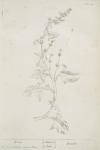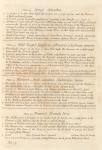1. It grows to be two Foot high, the Leaves are a grass Green, and the Flowers a light yellowish Green.
2. It is sown yearly in Gardens, and flowers according to the Months it is sow'd in.
3. Spinage is more used for Food than Medicine, being a good boil'd Sallad, and much eaten in the Spring, as good to temper the Heat & Sharpness of the Humours, it is esteemed cooling, moistning, & diuretic, rendring the Body soluble. Serapius an Arabian Physician says, that Spinage creates Wind; so that those who are troubled by Chollic had better not eat it.
4. Greek, Σπανάχιον. Latin, Spinachia or Lapathum hortense. Spanish, Spanache. Italian, Spinache. French, Espinoches. German, Spinat. Dutch, Spinasie.

 50. Wild Teasel. Dipsacus silvestris or Labrum veneris.
50. Wild Teasel. Dipsacus silvestris or Labrum veneris.
Also see #050, Wild Teasel. - #124. Shepherd's Staff.
1. This Teasel grows to be four or five Foot high, the Leaves are a light grass Green, and the Flowers purple.
2. It grows upon Banks in the borders of Fields, and flowers in June and July.
3. The Roots are esteemed cleansing; the Ancients commend a Decoction of them in Wine, boiled to a Consistence & kept in a brazen Vessel, to be applied to ye Rhagades, or Clefts of the Fundament, and for a Fistula therein; and to take away Warts. The Water found in the hollow of the Leaves is commended as a Collyrium to cool Inflammations of the Eyes; and as a Cosmetic to render the Face fair.
4. Greek, Δίψακος. Latin, Dipsacus silvestris or Labrum veneris. Spanish, Cardencha or Cardo penteador. Italian, Cardo da Panni & Dissaco. French, Cardon. German, dissil. Dutch, Groote Wildekaarden.

 51. Pilewort or Small Celendine. Chelidonium minus.
51. Pilewort or Small Celendine. Chelidonium minus.
Also see #031, Crow-foot.
1. The Stalks grow to be 6 or 8 Inches high; the Leaves are dark Green, and the Flowers a fine bright Yellow; the Root resembles the Piles in the Human Body.
2. It grows in Meadows, & moist Pastures, & by Hedges, and flowers in March & April.
3. This Herb is accounted to be good for the Haemorrhoids or Piles, to ease their Pain and Swelling & stop their bleeding, the Roots being taken inwardly, & an Ointment made of the Leaves & Roots applied outwardly. Some commend it for the Jaundice, & Scurvy, especially in the Mouth, to strengthen the Gums and preserve the Teeth.
4. Greek, Κελιδόνιον μεκρόν. Latin, Chelidonium minus. Spanish, Scrofolaria menor. Italian, Chelidonia minore. French, Covilos de Prestres. German, Pfaffenhodlin. Dutch, Kelynspeen-kruyd.
Also see #052. Primrose - #226. Cowslip
1. The Stalks grow to be eight or ten Inches high; the Leaves are a grass Green, & the Flowers a pale Yellow; and the Roots a reddish Purple.
2. It grows in Thickets, and under Hedges, and flowers in March and April.
3. The Flowers are commended as good against Disorders arising from phlegmatic Humours. The Juice of the Root is used as an Errhine to purge the Head of tough slimy Phlegm.
4. Greek, -. Latin, Primula Veris. Spanish, -. Italian, Fiore di Primavera. French, Primevere. German, Schlusselblumen. Dutch, Groote Wilde sleutel-blom.






